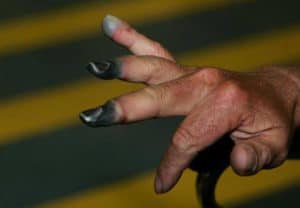We did a sweep of the Bear Pen Run loop. TheBear Pen Run Trail from the trailhead on the main entrance road up Bear Pen Run to North Boundary Trail to Buck and Doe, down the switchbacks to Bear Pen Run, then right returning to the trailhead. All was clear except for a 8 inch tree suspended about 20 inches above North Boundary Trail. More on frost bite.
The trail passed Watoga Lake, now safely frozen solid. I observed an ice-fisherman very gingerly removing his gloves just long enough to bait a hook and drop it into the augured hole. This on a morning where the predicted high is 2 degrees F. And gusts of wind that will bring anything above freezing down to the freezing point in a much accelerated rate. The fisherman was of course being prudent.
More on Frost Bite
Frostbite was discussed in the trail report a few weeks ago in some detail. But it cannot be expressed enough how insidious this condition is. It does not take long, particularly in weather like we have been experiencing of late, for the most vulnerable body parts to be frostbitten. As a response to low temperatures the body shunts blood away from extremities. This prevents a drop in core temperature in the area around the heart, lung, liver and kidneys. Unfortunately those areas farthest from the core such as the fingers, toes and earlobes are at great risk. Blood flow in the extremeties is greatly reduced. It is important to reduce or eliminate exposure of bare flesh to extremely cold temperatures, and to keep these areas covered.
To protect hands and fingers there is an advantage to wearing a mitten over a glove. Because a glove allows cold air to circulate between the fingers, the time to tissue damage is greatly reduced. The warming pads help tremendously (pictured) and are quite inexpensive. We used these this morning and the fingers were warm for the entire 2 1/2 hours on the trail. The package did not exaggerate the claim that they stay warm for many hours. They are sitting here beside me and are still toasty some 6 hours later.
It goes without saying that a warm hat that covers the ears should be worn in low temperatures. In addition to preventing frostbite it also helps prevent hypothermia because we lose a disproportionate amount of heat from the head and neck. Sometimes this is called “The Stovepipe Effect”.
 You don’t have to quit hiking in cold weather; just hike wisely.
You don’t have to quit hiking in cold weather; just hike wisely.
Warm and Safe Hiking,
Ken Springer